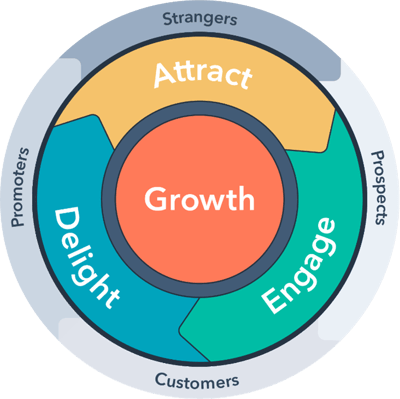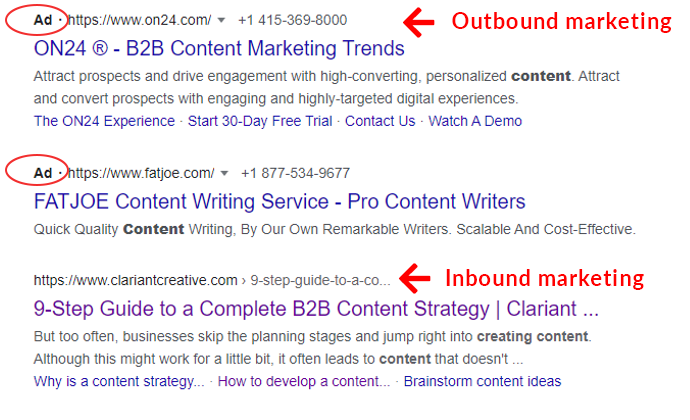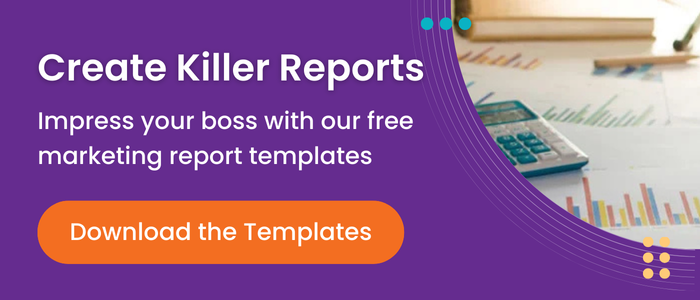When to Use Inbound Marketing vs Outbound Marketing

Why are marketers constantly talking about inbound and outbound marketing? Isn’t all marketing the same?
Not exactly.
Inbound marketing has vastly different approaches, strategies, and implementation from outbound marketing. And it’s growing in popularity: A January 2021 survey revealed B2B marketers in the U.S, are planning to spend over 14% more on inbound marketing, while outbound marketing dollars were expected to decrease by .6%
Is that the right approach, though? And what approach is right for your organization?
As it turns out, understanding the benefits and drawbacks of both marketing strategies is key for determining your overall marketing mix and getting ahead of the competition.
If you haven't yet formalized your own content strategy, don't worry ... our Complete B2B Content Strategy Pillar Page can help you know where to start out. You might also be interested in learning more about setting SMART goals for your marketing strategy.
What is inbound marketing?
Inbound marketing pulls people into your business.
The mindset behind inbound marketing is to earn brand awareness and build trust with potential customers by providing them immense value. They turn to you as a trusted resource, putting you top of mind when they’re ready to buy.
This journey from stranger to customer was traditionally envisioned as a funnel, where customers would follow a linear path from broad interest (awareness) to researching their options (consideration) to choosing where to buy (decision).
The problem with the funnel approach is that once people became customers, marketing had no use for them. Word of mouth has always been a powerful sales driver, but the funnel model didn’t take it into account.
So, Brian Halligan from HubSpot tossed out the funnel and introduced the flywheel.
With the flywheel, people still go through the same overarching steps of awareness, consideration, and decision, but another, very important step is added to the mix: promotion.
Now, the idea is that with the flywheel, you use thoughtful inbound marketing practices to:
- Attract strangers and turn them into prospects
- Engage prospects and turn them into customers
- Delight customers and turn them into promoters … who attract more strangers to your business.
 Okay, so this is all very theoretical, but what does it look like?
Okay, so this is all very theoretical, but what does it look like?
To illustrate, let’s say your business is called Running Shoe Store, and you want to get more customers.
The first question would be: Who are your customers? That’s your cue to create a buyer persona – a profile that paints a picture of your ideal customer and helps identify your messaging.
(That’s very much the TL;DR on buyer personas, but there’s much, much more to them. To dive into this important topic, check out our Guide to Buyer Personas.)
So, if we’re selling running shoes and have decided that one of our buyer personas is Bob the Beginning Runner, our inbound marketing content might look like this:
- Attract: Bob is thinking of taking up running and wants to learn more about how to get started. Good inbound marketing content for this stage would be a couch to 5K guide, linked with some blog posts about topics like beginner gear and how to run safely.
- Engage: At this stage of the buyer’s journey, Bob is actively shopping. Make it easier for him with a running shoe selector quiz and accompanying guide, user reviews, and a helpful chatbot who gives out coupon codes.
- Delight: Bob is sold. A thank-you note in his shipment and invitations to beginner running events in his area will keep him engaged, and so will content that helps him reach his goals, whether it’s running a 10K or finding the best running playlists. While talking about this weekend’s race, Bob’s co-worker says, “You know, I’ve thought about taking up running…” Bob’s reply? “Great idea! You should check out Running Shoe Store’s website. They’ve got a ton of great information that really helped me when I got started.”
And the flywheel keeps on spinning…
Now, keep in mind that this path isn’t always a continuum. Bob might settle on a few shoes but if he gets new information, he may veer back to the information-gathering stage. But, if you give Bob the helpful, interesting content he needs at each step of the way, sweeten the deal with reasons to shop with you, and then make him want to sing your praises as a customer, you’ve got a major edge over your competition.
This is why inbound marketing is so popular. It’s a powerful long-term approach that nurtures a relationship with a relevant audience, while providing value every step along the buyer’s journey and giving your business the opportunity to convert leads into customers.
Examples of inbound marketing
The mainstay of inbound marketing is content, which can be delivered through blogs, e-books, guides, case studies, and other downloadable content.
Another facet of inbound marketing is SEO (search engine optimization), which involves using keywords that are used in internet searches so when a customer searches for answers, you’re as close to the first result as possible. PPC (pay-per-click) ads use the same search principle as SEO but they’re paid ads, not simply organic links to content. Other examples of inbound marketing content include social media posts, opt-in emails, and landing pages with CTAs (calls to action).
All of these examples require time to nurture customer relationships, but the payoff is significant and long-lasting. Chief Marketer’s 2019 survey of B2B marketing professionals reported that email, SEO, and content marketing were considered to yield the highest return on investment. In a similar survey by eMarketer, 49% percent of B2B marketers felt that e-mail was the most effective for generating early-stage engagement.
Advantages of inbound marketing
With inbound marketing, you’re able to pull in users who are actively searching and interested in the information you’re offering.
After all, the thirst for relevant information is never quenched. By creating content that lines up with your customer’s interests, you can attract near- or in-market visitors to your website.
Another advantage is how you’ll be perceived by your target audience. When you provide useful and actionable content, visitors take notice. Your brand can grow naturally through Google ranking and word of mouth referrals, and so can your company’s recognition and authority within your niche. Many successful companies, such as HubSpot, BuzzSumo and Ahrefs, have built widely known and trusted brands by providing immense value through inbound marketing content.
What is outbound marketing?
Outbound marketing is what’s typically referred to as traditional marketing.
Traditional marketing is centered around paid advertisements in the form of cold calling, TV advertising, direct mail, radio ads, or print media. In the digital age, these ads might come in the form of pop-up ads, pay-per-click campaigns, or banner ads.

Outbound marketing is the process of pushing your brand’s message out to your target audience, even if they’re not actively looking for your products or services. This approach has a company seeking out and targeting potential customers, instead of letting clients come to you.
Why is outbound marketing so popular? It’s an immediate, hyper-targeted and scalable approach to get your message seen, creating awareness with people that may benefit, but not yet know about your business.
Another reason companies use outbound marketing? It’s been around for a very, very long time. For them, it’s comfortable – whether or not it’s the best choice for their target customers and their products and services.
Advantages of outbound marketing
One of the most valued aspects of outbound marketing is its targeting capabilities, especially when it comes to online outbound marketing.
Only want to show your ad to single moms who love Rob Lowe and live within a 25-mile geography of your brick-and-mortar business? Who knows why you’d want to do that, but you certainly can target that audience – no problem.
Outbound marketing offers the ability to set targeting restrictions based on a number of factors, such as demographics, geography, interests, and behaviors. This allows advertisers to target only the audience they select, which is a main reason why online advertising is such a popular method for lead generation.
Outbound marketing is also relatively easy to measure success, as advertising campaigns attribute dollar amounts to sales to simplify ad tracking.
When to use inbound marketing vs. outbound marketing
Now that we’ve covered the basics of inbound marketing and outbound marketing, as well as advantages of each, let’s look at three factors you should consider when investing in each marketing approach.
Budget
Launching an inbound marketing campaign can be extremely cost-efficient. In fact, HubSpot reports that businesses experience a 61% lower cost per lead when they’re focused on inbound marketing. One possible reason for this is the long-term, compounding value of building a relationship with your prospects, leading to word of mouth and search engine visibility.
By contrast, outbound marketing is pay to play. While the upfront and constant costs of outbound marketing’s pay-per-click approach might appear to favor inbound marketing’s cost-efficiency at first glance, it’s not necessary to pick one strategy over another. In fact, well-rounded marketers are more likely to integrate both strategies to yield a better return than either approach could yield alone.
For example, a holistic campaign might begin with paid advertising to reach a highly targeted, hard-to-find audience, and then once they’re email subscribers or social media followers, nurture that audience with helpful content. By combining both push and pull marketing strategies, you give your brand a powerful opportunity to begin a two-sided conversation with your prospects.
Additionally, outbound marketing can assist an inbound-first strategy by sending remarketing ads directly to people who have engaged with specific pieces of inbound content on your website.
The net result of combining both approaches is a highly customized and scalable approach that is both budget-conscious in the short term, and profitable over the long term.
Time
Outbound marketing excels at delivering results, in as little time as possible. While creating useful content takes time to write and get noticed by search engines, advertisements are immediate. Ads bring eyes to your products and services the minute they go live.
This short window from campaign launch to cash flow creates an immediate revenue stream, which is advantageous for investing in other tactics – including a complementary inbound campaign.
We’ve used this exact approach with clients to help them determine where their money is best spent. One client in particular budgets a portion of their marketing dollars for paid advertising to test the viability and consumer interest in new services. They can then cherry-pick which services would benefit from an inbound campaign (and have gained valuable data on what wording resonates with their ideal customers).
Inbound marketing is also tremendously useful for facilitating sales conversations with prospects that may have been introduced to your business due to push or outbound marketing, like ads or trade shows. With consistency, the seamless coordination between inbound and outbound will shave a ton of time off any traditional marketing plan.
Sustainability
How sustainable are inbound marketing and outbound marketing?
Both strategies need resources – whether it be time, effort, budget, or knowledge. Creating content might require you to hire writers, graphic designers, social media specialists, or other positions in creative fields. Outbound marketing might require gaining a deep understanding of how ads are priced or hiring traditional or digital media planners and buyers to your team.
Both strategies can be sustainable. And yet, both will require constant effort on your part to maintain any level of success. With that said, experienced marketers can attest to the fact that mixing inbound and outbound is ultimately more sustainable over the long haul.
Inbound marketing or outbound marketing? The answer: both.
Without an understanding of your unique priorities, it’s hard to know which marketing approach is best for your business. And you don’t need to pick one over the other –a common best practice is to combine both methods in tandem, as advertising strategies can be built around improving the profitability of inbound campaigns.
Source: GIPHY
Once you’ve created amazing marketing campaigns using inbound and outbound strategies, make sure to shine the most accurate, actionable light on your results, with our marketing reporting templates. These free templates will help you prove your marketing ROI and understand where you can make improvements.






